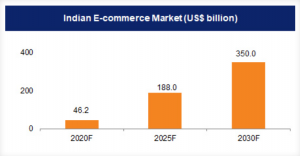
The NDA government led by Prime Minister Narendra Modi is all set to take on the dominant players in the Indian e-commerce space with the launch of Open Network for Digital Commerce. The ONDC pilot programme was launched in April this year. The network has been hailed as an alternative to global giants Amazon and Walmart-run Flipkart that dominate the fast-growing e-commerce segment.
The government is encouraged by the huge success of Unified Payments Interface (UPI), an instant real-time payment system developed by National Payments Corporation of India, and hopes to pull off another success story with ONDC. However, executing the ambitious ONDC may not be as easy as developing a digital payments system.
While Amazon and Walmart’s Flipkart together control more than 60% of the market, Mukesh Ambani-led Reliance and a clutch of Tata Group companies have joined the lucrative e-commerce industry.
ALSO READ: Mobile manufacturing: India struggles against Chinese dominance
What is ONDC?
With ONDC, the government looks to take Indian e-commerce penetration to another level in the coming two years and aims to more than triple the current consumer purchases in a country of 1.35 billion people. The goal is not just to woo customers, but also bring 1.2 million sellers on board the shared network within the next five years, while achieving gross merchandise value of $48 billion. India has been witnessing a boom in the e-commerce space and it is expected that the market will touch $350 billion by the end of this decade.

ONDC is a non-profit company which aims at enabling display of the products and services of all participating players on a single network and these results will show up on the search results across all apps on the network. While the government hopes that global players with already settled consumer base will also join the network, it is not clear as to what is there for these players to gain.
So far, as many as two dozen companies including Flipkart-backed logistics provider Ekart Logistics, hyperlocal quick commerce company Dunzo, and digital payments company PhonePe have shown interest and are in the process of integrating in the network. Real time transactions in the retail and food delivery space have already started in cities such as Delhi, Bhopal, Bengaluru and Shillong.
How ONDC is different from existing e-commerce players?
ONDC is to be based on open-sourced methodology, and will use open specifications and open network protocols independent of any specific platform. Unlike Amazon or Flipkart, where the buyer and seller have to use the same platform or application to be digitally visible and do a business transaction, ONDC goes beyond the current platform-centric digital commerce model. This will be more akin to hypertext transfer protocol for information exchange over internet, simple mail transfer protocol for exchange of emails and unified payments interface for payments.
ALSO READ: Covid-19: Kerala Model is the success of decentralised democracy
Why is UPI drawing comparisons with ONDC?
The primary function of UPI is to provide a safe ecosystem for digital payments while also providing secure transfer of financial data across participants including banks, customers and wallets. In India, the interface became especially pertinent after the demonetisation in 2016 that led to cash shortages across India.
While implementing UPI seemed a herculean task at first in a country which values physical money much more than digital currency, UPI was a success. UPI gave unprecedented comfort in terms of settling payments which led to mass adoption of platforms such as Paytm, PhonePe, and government-run BHIM.
In the case of UPI, there are negligible subjective variables such as quality of products, reliability of the seller/buyer, speed of delivery etc, and there is no real interaction with the physical world as the entire process takes place digitally. On the other hand, while buyers and sellers are online in the case of ONDC, the delivery of the product is offline which may cause disputes.
Challenges ahead
The interface is reeling under implementation challenges even though the programme is live in 20-odd locations, equity research firm Jefferies said in a recent report. Comparing it to the success story of UPI, the research firm said that the digital payments interface faced far simpler issues while ONDC has many problems to tackle.
Moreover, UPI was a unique take on settling payments as it was a one-of-a-kind product in the market. It is questionable why buyers will move to an unfamiliar ecosystem especially when Amazon and Flipkart usually offer an ease of usage and most buyers are able to find what they need. Simply put, what ONDC is offering in terms of ease and added reliability for buyers to make a switch? This is an especially burning question in a country where ‘sarkari’ is often synonymous with unreliable and public grievance redressal is non-existent.
Leading trade union CAIT has already pointed out faults with ONDC which aims mainly to tap millions of small businesses that often lack technological expertise. The government will have to run a massive awareness campaign to get them on board. Of India’s total retail trade, only 5-6% is online.
Further, while the government looks to check predatory pricing, smaller businesses with low volumes may also lack the resources to match the discounts offered by heavyweights like Amazon and Flipkart which have deep cash pockets and can afford to provide heavy discounts. So, as with most government policies, ONDC too may end up on paper, but impractical in reality.
